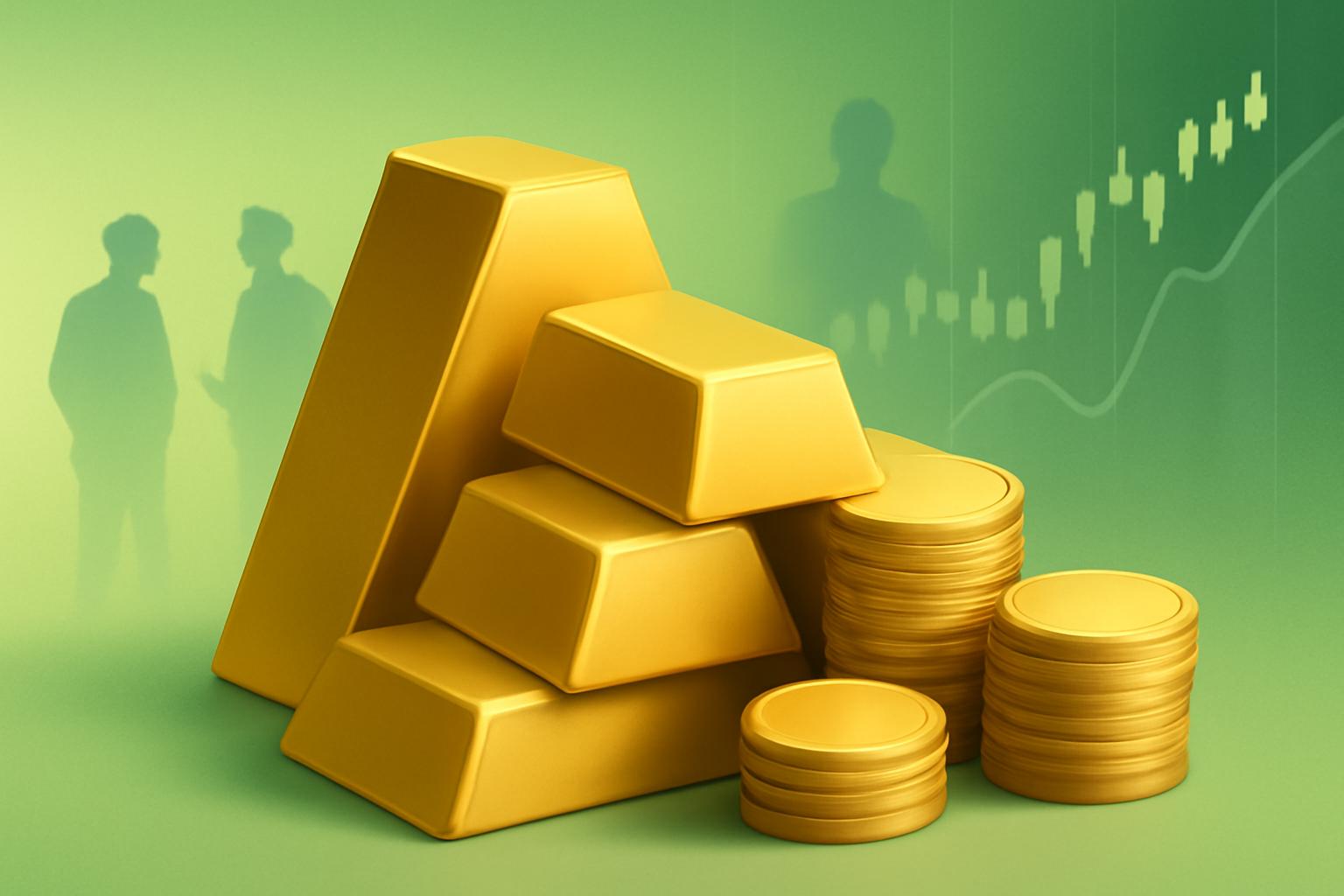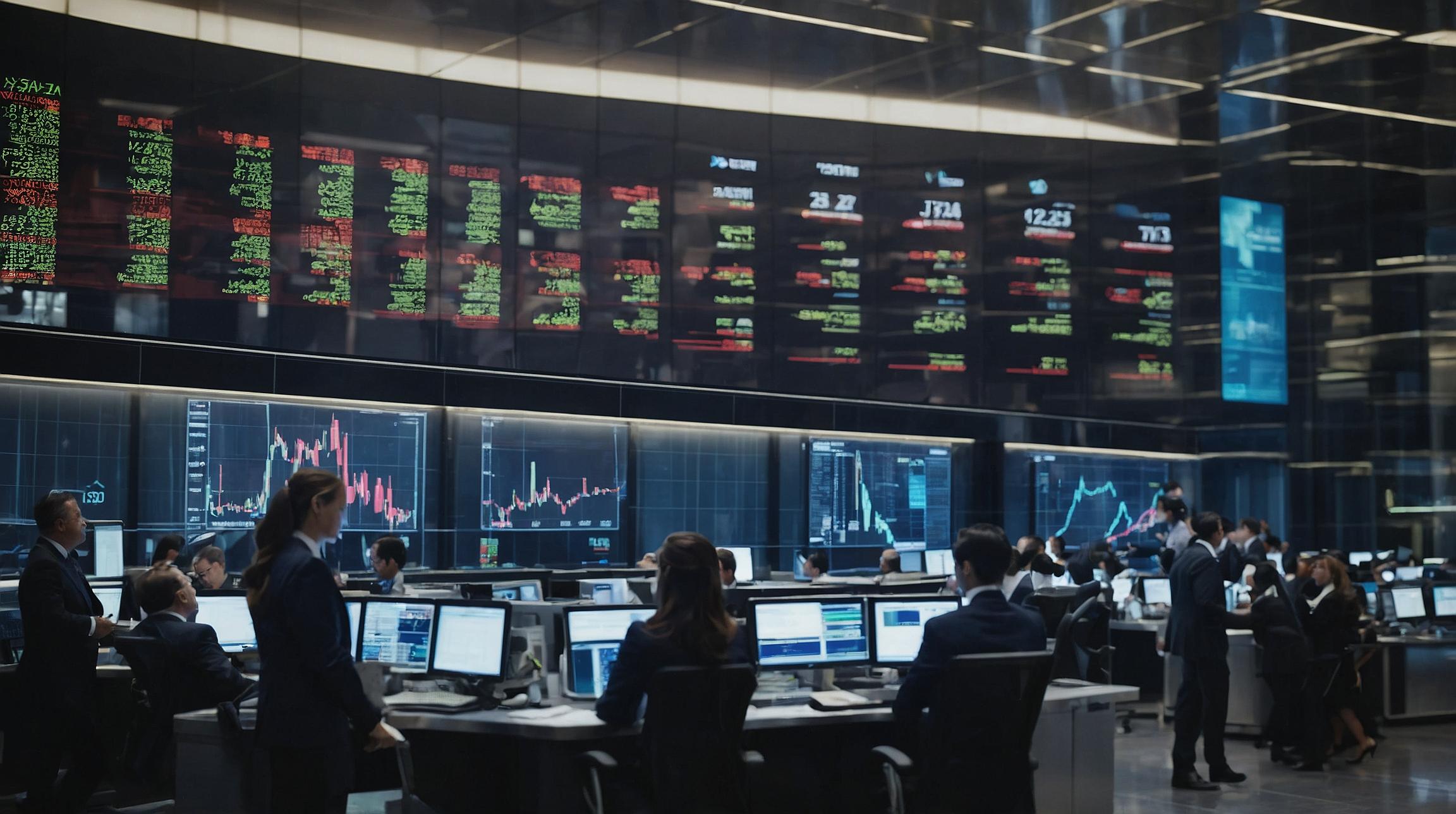Market experts advise maintaining a balanced portfolio allocation to gold. Mukesh Jindal recommends 5% to 10% exposure, while billionaire investor Ray Dalio has suggested allocations as high as 15%. !-- wp:paragraph -->
FinOracleAI — Market View
India’s gold market demonstrates robust demand resilience despite high prices, driven by cultural factors and increasing investor interest in gold as a strategic asset amid macroeconomic uncertainties. !-- wp:paragraph -->- Opportunities: Strong retail and institutional demand; diversification benefits amid currency and equity market volatility; expanding gold investment products.
- Risks: Price volatility; potential supply constraints in physical gold coins and bars; geopolitical tensions affecting global gold prices.
Impact: The sustained gold demand in India reinforces gold’s role as a key investment and wealth preservation asset, supporting prices and market stability despite periodic fluctuations.
Data from the Association of Mutual Funds in India reveals a sixfold increase in gold ETF inflows in September compared to the previous year, rising to 83.63 billion rupees. This trend highlights the growing preference among retail investors for diversified and convenient gold exposure. !-- wp:paragraph -->“We view this as a structural shift in reserve management behavior, and we do not expect a near-term reversal,” said Goldman Sachs in a recent report on central bank gold purchases. Market experts advise maintaining a balanced portfolio allocation to gold. Mukesh Jindal recommends 5% to 10% exposure, while billionaire investor Ray Dalio has suggested allocations as high as 15%.
!-- wp:paragraph -->FinOracleAI — Market View
India’s gold market demonstrates robust demand resilience despite high prices, driven by cultural factors and increasing investor interest in gold as a strategic asset amid macroeconomic uncertainties. !-- wp:paragraph -->- Opportunities: Strong retail and institutional demand; diversification benefits amid currency and equity market volatility; expanding gold investment products.
- Risks: Price volatility; potential supply constraints in physical gold coins and bars; geopolitical tensions affecting global gold prices.
Impact: The sustained gold demand in India reinforces gold’s role as a key investment and wealth preservation asset, supporting prices and market stability despite periodic fluctuations.
Morgan Stanley estimates that Indian households hold approximately $3.8 trillion worth of gold, equivalent to nearly 89% of the country’s GDP, underscoring gold’s integral role in national wealth. !-- wp:paragraph --> According to Mukesh Jindal, senior partner at Alpha Capital, gold serves as a hedge against rupee depreciation and equity market volatility. Investment vehicles include physical gold bars and coins, gold exchange-traded funds (ETFs), and digital gold platforms. !-- wp:paragraph -->Surge in Gold ETF Investments
Data from the Association of Mutual Funds in India reveals a sixfold increase in gold ETF inflows in September compared to the previous year, rising to 83.63 billion rupees. This trend highlights the growing preference among retail investors for diversified and convenient gold exposure. !-- wp:paragraph -->“We view this as a structural shift in reserve management behavior, and we do not expect a near-term reversal,” said Goldman Sachs in a recent report on central bank gold purchases. Market experts advise maintaining a balanced portfolio allocation to gold. Mukesh Jindal recommends 5% to 10% exposure, while billionaire investor Ray Dalio has suggested allocations as high as 15%.
!-- wp:paragraph -->FinOracleAI — Market View
India’s gold market demonstrates robust demand resilience despite high prices, driven by cultural factors and increasing investor interest in gold as a strategic asset amid macroeconomic uncertainties. !-- wp:paragraph -->- Opportunities: Strong retail and institutional demand; diversification benefits amid currency and equity market volatility; expanding gold investment products.
- Risks: Price volatility; potential supply constraints in physical gold coins and bars; geopolitical tensions affecting global gold prices.
Impact: The sustained gold demand in India reinforces gold’s role as a key investment and wealth preservation asset, supporting prices and market stability despite periodic fluctuations.
India remains the world’s second-largest gold consumer after China, driven historically by cultural demand during festivals and weddings. Despite elevated prices, overall gold volume sales during Diwali were only about 5% lower than last year, indicating resilient demand. !-- wp:paragraph --> Morgan Stanley estimates that Indian households hold approximately $3.8 trillion worth of gold, equivalent to nearly 89% of the country’s GDP, underscoring gold’s integral role in national wealth. !-- wp:paragraph --> According to Mukesh Jindal, senior partner at Alpha Capital, gold serves as a hedge against rupee depreciation and equity market volatility. Investment vehicles include physical gold bars and coins, gold exchange-traded funds (ETFs), and digital gold platforms. !-- wp:paragraph -->Surge in Gold ETF Investments
Data from the Association of Mutual Funds in India reveals a sixfold increase in gold ETF inflows in September compared to the previous year, rising to 83.63 billion rupees. This trend highlights the growing preference among retail investors for diversified and convenient gold exposure. !-- wp:paragraph -->“We view this as a structural shift in reserve management behavior, and we do not expect a near-term reversal,” said Goldman Sachs in a recent report on central bank gold purchases. Market experts advise maintaining a balanced portfolio allocation to gold. Mukesh Jindal recommends 5% to 10% exposure, while billionaire investor Ray Dalio has suggested allocations as high as 15%.
!-- wp:paragraph -->FinOracleAI — Market View
India’s gold market demonstrates robust demand resilience despite high prices, driven by cultural factors and increasing investor interest in gold as a strategic asset amid macroeconomic uncertainties. !-- wp:paragraph -->- Opportunities: Strong retail and institutional demand; diversification benefits amid currency and equity market volatility; expanding gold investment products.
- Risks: Price volatility; potential supply constraints in physical gold coins and bars; geopolitical tensions affecting global gold prices.
Impact: The sustained gold demand in India reinforces gold’s role as a key investment and wealth preservation asset, supporting prices and market stability despite periodic fluctuations.
India remains the world’s second-largest gold consumer after China, driven historically by cultural demand during festivals and weddings. Despite elevated prices, overall gold volume sales during Diwali were only about 5% lower than last year, indicating resilient demand. !-- wp:paragraph --> Morgan Stanley estimates that Indian households hold approximately $3.8 trillion worth of gold, equivalent to nearly 89% of the country’s GDP, underscoring gold’s integral role in national wealth. !-- wp:paragraph --> According to Mukesh Jindal, senior partner at Alpha Capital, gold serves as a hedge against rupee depreciation and equity market volatility. Investment vehicles include physical gold bars and coins, gold exchange-traded funds (ETFs), and digital gold platforms. !-- wp:paragraph -->Surge in Gold ETF Investments
Data from the Association of Mutual Funds in India reveals a sixfold increase in gold ETF inflows in September compared to the previous year, rising to 83.63 billion rupees. This trend highlights the growing preference among retail investors for diversified and convenient gold exposure. !-- wp:paragraph -->“We view this as a structural shift in reserve management behavior, and we do not expect a near-term reversal,” said Goldman Sachs in a recent report on central bank gold purchases. Market experts advise maintaining a balanced portfolio allocation to gold. Mukesh Jindal recommends 5% to 10% exposure, while billionaire investor Ray Dalio has suggested allocations as high as 15%.
!-- wp:paragraph -->FinOracleAI — Market View
India’s gold market demonstrates robust demand resilience despite high prices, driven by cultural factors and increasing investor interest in gold as a strategic asset amid macroeconomic uncertainties. !-- wp:paragraph -->- Opportunities: Strong retail and institutional demand; diversification benefits amid currency and equity market volatility; expanding gold investment products.
- Risks: Price volatility; potential supply constraints in physical gold coins and bars; geopolitical tensions affecting global gold prices.
Impact: The sustained gold demand in India reinforces gold’s role as a key investment and wealth preservation asset, supporting prices and market stability despite periodic fluctuations.
Gold prices have experienced significant volatility this year. After rising 66% by mid-October, prices retreated sharply but remained elevated, trading around $4,073 per ounce as of late October. Earlier in the month, gold breached the $4,000 mark, with some experts forecasting prices could reach $5,000 per ounce in 2026. !-- wp:paragraph --> This rally is underpinned by sustained central bank purchases, particularly among emerging markets. According to Goldman Sachs, the pace of central bank gold acquisitions has increased fivefold since 2022, a structural shift in reserve management unlikely to reverse in the near term. !-- wp:paragraph -->India’s Traditional and Emerging Gold Demand Drivers
India remains the world’s second-largest gold consumer after China, driven historically by cultural demand during festivals and weddings. Despite elevated prices, overall gold volume sales during Diwali were only about 5% lower than last year, indicating resilient demand. !-- wp:paragraph --> Morgan Stanley estimates that Indian households hold approximately $3.8 trillion worth of gold, equivalent to nearly 89% of the country’s GDP, underscoring gold’s integral role in national wealth. !-- wp:paragraph --> According to Mukesh Jindal, senior partner at Alpha Capital, gold serves as a hedge against rupee depreciation and equity market volatility. Investment vehicles include physical gold bars and coins, gold exchange-traded funds (ETFs), and digital gold platforms. !-- wp:paragraph -->Surge in Gold ETF Investments
Data from the Association of Mutual Funds in India reveals a sixfold increase in gold ETF inflows in September compared to the previous year, rising to 83.63 billion rupees. This trend highlights the growing preference among retail investors for diversified and convenient gold exposure. !-- wp:paragraph -->“We view this as a structural shift in reserve management behavior, and we do not expect a near-term reversal,” said Goldman Sachs in a recent report on central bank gold purchases. Market experts advise maintaining a balanced portfolio allocation to gold. Mukesh Jindal recommends 5% to 10% exposure, while billionaire investor Ray Dalio has suggested allocations as high as 15%.
!-- wp:paragraph -->FinOracleAI — Market View
India’s gold market demonstrates robust demand resilience despite high prices, driven by cultural factors and increasing investor interest in gold as a strategic asset amid macroeconomic uncertainties. !-- wp:paragraph -->- Opportunities: Strong retail and institutional demand; diversification benefits amid currency and equity market volatility; expanding gold investment products.
- Risks: Price volatility; potential supply constraints in physical gold coins and bars; geopolitical tensions affecting global gold prices.
Impact: The sustained gold demand in India reinforces gold’s role as a key investment and wealth preservation asset, supporting prices and market stability despite periodic fluctuations.
Gold prices have experienced significant volatility this year. After rising 66% by mid-October, prices retreated sharply but remained elevated, trading around $4,073 per ounce as of late October. Earlier in the month, gold breached the $4,000 mark, with some experts forecasting prices could reach $5,000 per ounce in 2026. !-- wp:paragraph --> This rally is underpinned by sustained central bank purchases, particularly among emerging markets. According to Goldman Sachs, the pace of central bank gold acquisitions has increased fivefold since 2022, a structural shift in reserve management unlikely to reverse in the near term. !-- wp:paragraph -->India’s Traditional and Emerging Gold Demand Drivers
India remains the world’s second-largest gold consumer after China, driven historically by cultural demand during festivals and weddings. Despite elevated prices, overall gold volume sales during Diwali were only about 5% lower than last year, indicating resilient demand. !-- wp:paragraph --> Morgan Stanley estimates that Indian households hold approximately $3.8 trillion worth of gold, equivalent to nearly 89% of the country’s GDP, underscoring gold’s integral role in national wealth. !-- wp:paragraph --> According to Mukesh Jindal, senior partner at Alpha Capital, gold serves as a hedge against rupee depreciation and equity market volatility. Investment vehicles include physical gold bars and coins, gold exchange-traded funds (ETFs), and digital gold platforms. !-- wp:paragraph -->Surge in Gold ETF Investments
Data from the Association of Mutual Funds in India reveals a sixfold increase in gold ETF inflows in September compared to the previous year, rising to 83.63 billion rupees. This trend highlights the growing preference among retail investors for diversified and convenient gold exposure. !-- wp:paragraph -->“We view this as a structural shift in reserve management behavior, and we do not expect a near-term reversal,” said Goldman Sachs in a recent report on central bank gold purchases. Market experts advise maintaining a balanced portfolio allocation to gold. Mukesh Jindal recommends 5% to 10% exposure, while billionaire investor Ray Dalio has suggested allocations as high as 15%.
!-- wp:paragraph -->FinOracleAI — Market View
India’s gold market demonstrates robust demand resilience despite high prices, driven by cultural factors and increasing investor interest in gold as a strategic asset amid macroeconomic uncertainties. !-- wp:paragraph -->- Opportunities: Strong retail and institutional demand; diversification benefits amid currency and equity market volatility; expanding gold investment products.
- Risks: Price volatility; potential supply constraints in physical gold coins and bars; geopolitical tensions affecting global gold prices.
Impact: The sustained gold demand in India reinforces gold’s role as a key investment and wealth preservation asset, supporting prices and market stability despite periodic fluctuations.
Mahavir Kothari, a wholesaler in Zaveri Bazaar, confirmed that most buyers preferred coins and bars rather than jewelry. Industry insiders estimate that jewelry sales declined by approximately 30% compared to the previous festive season, reflecting a growing investment focus among Indian consumers. !-- wp:paragraph --> Ajay Chawla, CEO of Tanishq, one of India’s largest jewelry chains, warned of potential shortages of gold coins and bars due to heightened demand during the festival. !-- wp:paragraph -->Gold Price Dynamics and Market Drivers
Gold prices have experienced significant volatility this year. After rising 66% by mid-October, prices retreated sharply but remained elevated, trading around $4,073 per ounce as of late October. Earlier in the month, gold breached the $4,000 mark, with some experts forecasting prices could reach $5,000 per ounce in 2026. !-- wp:paragraph --> This rally is underpinned by sustained central bank purchases, particularly among emerging markets. According to Goldman Sachs, the pace of central bank gold acquisitions has increased fivefold since 2022, a structural shift in reserve management unlikely to reverse in the near term. !-- wp:paragraph -->India’s Traditional and Emerging Gold Demand Drivers
India remains the world’s second-largest gold consumer after China, driven historically by cultural demand during festivals and weddings. Despite elevated prices, overall gold volume sales during Diwali were only about 5% lower than last year, indicating resilient demand. !-- wp:paragraph --> Morgan Stanley estimates that Indian households hold approximately $3.8 trillion worth of gold, equivalent to nearly 89% of the country’s GDP, underscoring gold’s integral role in national wealth. !-- wp:paragraph --> According to Mukesh Jindal, senior partner at Alpha Capital, gold serves as a hedge against rupee depreciation and equity market volatility. Investment vehicles include physical gold bars and coins, gold exchange-traded funds (ETFs), and digital gold platforms. !-- wp:paragraph -->Surge in Gold ETF Investments
Data from the Association of Mutual Funds in India reveals a sixfold increase in gold ETF inflows in September compared to the previous year, rising to 83.63 billion rupees. This trend highlights the growing preference among retail investors for diversified and convenient gold exposure. !-- wp:paragraph -->“We view this as a structural shift in reserve management behavior, and we do not expect a near-term reversal,” said Goldman Sachs in a recent report on central bank gold purchases. Market experts advise maintaining a balanced portfolio allocation to gold. Mukesh Jindal recommends 5% to 10% exposure, while billionaire investor Ray Dalio has suggested allocations as high as 15%.
!-- wp:paragraph -->FinOracleAI — Market View
India’s gold market demonstrates robust demand resilience despite high prices, driven by cultural factors and increasing investor interest in gold as a strategic asset amid macroeconomic uncertainties. !-- wp:paragraph -->- Opportunities: Strong retail and institutional demand; diversification benefits amid currency and equity market volatility; expanding gold investment products.
- Risks: Price volatility; potential supply constraints in physical gold coins and bars; geopolitical tensions affecting global gold prices.
Impact: The sustained gold demand in India reinforces gold’s role as a key investment and wealth preservation asset, supporting prices and market stability despite periodic fluctuations.
Mahavir Kothari, a wholesaler in Zaveri Bazaar, confirmed that most buyers preferred coins and bars rather than jewelry. Industry insiders estimate that jewelry sales declined by approximately 30% compared to the previous festive season, reflecting a growing investment focus among Indian consumers. !-- wp:paragraph --> Ajay Chawla, CEO of Tanishq, one of India’s largest jewelry chains, warned of potential shortages of gold coins and bars due to heightened demand during the festival. !-- wp:paragraph -->Gold Price Dynamics and Market Drivers
Gold prices have experienced significant volatility this year. After rising 66% by mid-October, prices retreated sharply but remained elevated, trading around $4,073 per ounce as of late October. Earlier in the month, gold breached the $4,000 mark, with some experts forecasting prices could reach $5,000 per ounce in 2026. !-- wp:paragraph --> This rally is underpinned by sustained central bank purchases, particularly among emerging markets. According to Goldman Sachs, the pace of central bank gold acquisitions has increased fivefold since 2022, a structural shift in reserve management unlikely to reverse in the near term. !-- wp:paragraph -->India’s Traditional and Emerging Gold Demand Drivers
India remains the world’s second-largest gold consumer after China, driven historically by cultural demand during festivals and weddings. Despite elevated prices, overall gold volume sales during Diwali were only about 5% lower than last year, indicating resilient demand. !-- wp:paragraph --> Morgan Stanley estimates that Indian households hold approximately $3.8 trillion worth of gold, equivalent to nearly 89% of the country’s GDP, underscoring gold’s integral role in national wealth. !-- wp:paragraph --> According to Mukesh Jindal, senior partner at Alpha Capital, gold serves as a hedge against rupee depreciation and equity market volatility. Investment vehicles include physical gold bars and coins, gold exchange-traded funds (ETFs), and digital gold platforms. !-- wp:paragraph -->Surge in Gold ETF Investments
Data from the Association of Mutual Funds in India reveals a sixfold increase in gold ETF inflows in September compared to the previous year, rising to 83.63 billion rupees. This trend highlights the growing preference among retail investors for diversified and convenient gold exposure. !-- wp:paragraph -->“We view this as a structural shift in reserve management behavior, and we do not expect a near-term reversal,” said Goldman Sachs in a recent report on central bank gold purchases. Market experts advise maintaining a balanced portfolio allocation to gold. Mukesh Jindal recommends 5% to 10% exposure, while billionaire investor Ray Dalio has suggested allocations as high as 15%.
!-- wp:paragraph -->FinOracleAI — Market View
India’s gold market demonstrates robust demand resilience despite high prices, driven by cultural factors and increasing investor interest in gold as a strategic asset amid macroeconomic uncertainties. !-- wp:paragraph -->- Opportunities: Strong retail and institutional demand; diversification benefits amid currency and equity market volatility; expanding gold investment products.
- Risks: Price volatility; potential supply constraints in physical gold coins and bars; geopolitical tensions affecting global gold prices.
Impact: The sustained gold demand in India reinforces gold’s role as a key investment and wealth preservation asset, supporting prices and market stability despite periodic fluctuations.
India’s gold market experienced a surge in demand this Diwali, with sales estimated between 700 billion and 1 trillion rupees ($8 billion to $11 billion) over the five-day festival period ending October 24, according to the India Bullion and Jewellers Association (IBJA) and the All India Gem and Jewellery Domestic Council (GJC). On the first day alone, more than 40 tons of gold changed hands across the country. !-- wp:paragraph --> The bustling Zaveri Bazaar in Mumbai, a historic hub for precious metals, saw unprecedented crowds, but with a notable trend: consumers increasingly favored gold coins and bars over traditional jewelry, signaling a shift in buying behavior. !-- wp:paragraph -->Shift from Jewelry to Investment-Oriented Gold
Mahavir Kothari, a wholesaler in Zaveri Bazaar, confirmed that most buyers preferred coins and bars rather than jewelry. Industry insiders estimate that jewelry sales declined by approximately 30% compared to the previous festive season, reflecting a growing investment focus among Indian consumers. !-- wp:paragraph --> Ajay Chawla, CEO of Tanishq, one of India’s largest jewelry chains, warned of potential shortages of gold coins and bars due to heightened demand during the festival. !-- wp:paragraph -->Gold Price Dynamics and Market Drivers
Gold prices have experienced significant volatility this year. After rising 66% by mid-October, prices retreated sharply but remained elevated, trading around $4,073 per ounce as of late October. Earlier in the month, gold breached the $4,000 mark, with some experts forecasting prices could reach $5,000 per ounce in 2026. !-- wp:paragraph --> This rally is underpinned by sustained central bank purchases, particularly among emerging markets. According to Goldman Sachs, the pace of central bank gold acquisitions has increased fivefold since 2022, a structural shift in reserve management unlikely to reverse in the near term. !-- wp:paragraph -->India’s Traditional and Emerging Gold Demand Drivers
India remains the world’s second-largest gold consumer after China, driven historically by cultural demand during festivals and weddings. Despite elevated prices, overall gold volume sales during Diwali were only about 5% lower than last year, indicating resilient demand. !-- wp:paragraph --> Morgan Stanley estimates that Indian households hold approximately $3.8 trillion worth of gold, equivalent to nearly 89% of the country’s GDP, underscoring gold’s integral role in national wealth. !-- wp:paragraph --> According to Mukesh Jindal, senior partner at Alpha Capital, gold serves as a hedge against rupee depreciation and equity market volatility. Investment vehicles include physical gold bars and coins, gold exchange-traded funds (ETFs), and digital gold platforms. !-- wp:paragraph -->Surge in Gold ETF Investments
Data from the Association of Mutual Funds in India reveals a sixfold increase in gold ETF inflows in September compared to the previous year, rising to 83.63 billion rupees. This trend highlights the growing preference among retail investors for diversified and convenient gold exposure. !-- wp:paragraph -->“We view this as a structural shift in reserve management behavior, and we do not expect a near-term reversal,” said Goldman Sachs in a recent report on central bank gold purchases. Market experts advise maintaining a balanced portfolio allocation to gold. Mukesh Jindal recommends 5% to 10% exposure, while billionaire investor Ray Dalio has suggested allocations as high as 15%.
!-- wp:paragraph -->FinOracleAI — Market View
India’s gold market demonstrates robust demand resilience despite high prices, driven by cultural factors and increasing investor interest in gold as a strategic asset amid macroeconomic uncertainties. !-- wp:paragraph -->- Opportunities: Strong retail and institutional demand; diversification benefits amid currency and equity market volatility; expanding gold investment products.
- Risks: Price volatility; potential supply constraints in physical gold coins and bars; geopolitical tensions affecting global gold prices.
Impact: The sustained gold demand in India reinforces gold’s role as a key investment and wealth preservation asset, supporting prices and market stability despite periodic fluctuations.
India’s gold market experienced a surge in demand this Diwali, with sales estimated between 700 billion and 1 trillion rupees ($8 billion to $11 billion) over the five-day festival period ending October 24, according to the India Bullion and Jewellers Association (IBJA) and the All India Gem and Jewellery Domestic Council (GJC). On the first day alone, more than 40 tons of gold changed hands across the country. !-- wp:paragraph --> The bustling Zaveri Bazaar in Mumbai, a historic hub for precious metals, saw unprecedented crowds, but with a notable trend: consumers increasingly favored gold coins and bars over traditional jewelry, signaling a shift in buying behavior. !-- wp:paragraph -->Shift from Jewelry to Investment-Oriented Gold
Mahavir Kothari, a wholesaler in Zaveri Bazaar, confirmed that most buyers preferred coins and bars rather than jewelry. Industry insiders estimate that jewelry sales declined by approximately 30% compared to the previous festive season, reflecting a growing investment focus among Indian consumers. !-- wp:paragraph --> Ajay Chawla, CEO of Tanishq, one of India’s largest jewelry chains, warned of potential shortages of gold coins and bars due to heightened demand during the festival. !-- wp:paragraph -->Gold Price Dynamics and Market Drivers
Gold prices have experienced significant volatility this year. After rising 66% by mid-October, prices retreated sharply but remained elevated, trading around $4,073 per ounce as of late October. Earlier in the month, gold breached the $4,000 mark, with some experts forecasting prices could reach $5,000 per ounce in 2026. !-- wp:paragraph --> This rally is underpinned by sustained central bank purchases, particularly among emerging markets. According to Goldman Sachs, the pace of central bank gold acquisitions has increased fivefold since 2022, a structural shift in reserve management unlikely to reverse in the near term. !-- wp:paragraph -->India’s Traditional and Emerging Gold Demand Drivers
India remains the world’s second-largest gold consumer after China, driven historically by cultural demand during festivals and weddings. Despite elevated prices, overall gold volume sales during Diwali were only about 5% lower than last year, indicating resilient demand. !-- wp:paragraph --> Morgan Stanley estimates that Indian households hold approximately $3.8 trillion worth of gold, equivalent to nearly 89% of the country’s GDP, underscoring gold’s integral role in national wealth. !-- wp:paragraph --> According to Mukesh Jindal, senior partner at Alpha Capital, gold serves as a hedge against rupee depreciation and equity market volatility. Investment vehicles include physical gold bars and coins, gold exchange-traded funds (ETFs), and digital gold platforms. !-- wp:paragraph -->Surge in Gold ETF Investments
Data from the Association of Mutual Funds in India reveals a sixfold increase in gold ETF inflows in September compared to the previous year, rising to 83.63 billion rupees. This trend highlights the growing preference among retail investors for diversified and convenient gold exposure. !-- wp:paragraph -->“We view this as a structural shift in reserve management behavior, and we do not expect a near-term reversal,” said Goldman Sachs in a recent report on central bank gold purchases. Market experts advise maintaining a balanced portfolio allocation to gold. Mukesh Jindal recommends 5% to 10% exposure, while billionaire investor Ray Dalio has suggested allocations as high as 15%.
!-- wp:paragraph -->FinOracleAI — Market View
India’s gold market demonstrates robust demand resilience despite high prices, driven by cultural factors and increasing investor interest in gold as a strategic asset amid macroeconomic uncertainties. !-- wp:paragraph -->- Opportunities: Strong retail and institutional demand; diversification benefits amid currency and equity market volatility; expanding gold investment products.
- Risks: Price volatility; potential supply constraints in physical gold coins and bars; geopolitical tensions affecting global gold prices.
Impact: The sustained gold demand in India reinforces gold’s role as a key investment and wealth preservation asset, supporting prices and market stability despite periodic fluctuations.
Robust Gold Demand in India During Diwali Festival
India’s gold market experienced a surge in demand this Diwali, with sales estimated between 700 billion and 1 trillion rupees ($8 billion to $11 billion) over the five-day festival period ending October 24, according to the India Bullion and Jewellers Association (IBJA) and the All India Gem and Jewellery Domestic Council (GJC). On the first day alone, more than 40 tons of gold changed hands across the country. !-- wp:paragraph --> The bustling Zaveri Bazaar in Mumbai, a historic hub for precious metals, saw unprecedented crowds, but with a notable trend: consumers increasingly favored gold coins and bars over traditional jewelry, signaling a shift in buying behavior. !-- wp:paragraph -->Shift from Jewelry to Investment-Oriented Gold
Mahavir Kothari, a wholesaler in Zaveri Bazaar, confirmed that most buyers preferred coins and bars rather than jewelry. Industry insiders estimate that jewelry sales declined by approximately 30% compared to the previous festive season, reflecting a growing investment focus among Indian consumers. !-- wp:paragraph --> Ajay Chawla, CEO of Tanishq, one of India’s largest jewelry chains, warned of potential shortages of gold coins and bars due to heightened demand during the festival. !-- wp:paragraph -->Gold Price Dynamics and Market Drivers
Gold prices have experienced significant volatility this year. After rising 66% by mid-October, prices retreated sharply but remained elevated, trading around $4,073 per ounce as of late October. Earlier in the month, gold breached the $4,000 mark, with some experts forecasting prices could reach $5,000 per ounce in 2026. !-- wp:paragraph --> This rally is underpinned by sustained central bank purchases, particularly among emerging markets. According to Goldman Sachs, the pace of central bank gold acquisitions has increased fivefold since 2022, a structural shift in reserve management unlikely to reverse in the near term. !-- wp:paragraph -->India’s Traditional and Emerging Gold Demand Drivers
India remains the world’s second-largest gold consumer after China, driven historically by cultural demand during festivals and weddings. Despite elevated prices, overall gold volume sales during Diwali were only about 5% lower than last year, indicating resilient demand. !-- wp:paragraph --> Morgan Stanley estimates that Indian households hold approximately $3.8 trillion worth of gold, equivalent to nearly 89% of the country’s GDP, underscoring gold’s integral role in national wealth. !-- wp:paragraph --> According to Mukesh Jindal, senior partner at Alpha Capital, gold serves as a hedge against rupee depreciation and equity market volatility. Investment vehicles include physical gold bars and coins, gold exchange-traded funds (ETFs), and digital gold platforms. !-- wp:paragraph -->Surge in Gold ETF Investments
Data from the Association of Mutual Funds in India reveals a sixfold increase in gold ETF inflows in September compared to the previous year, rising to 83.63 billion rupees. This trend highlights the growing preference among retail investors for diversified and convenient gold exposure. !-- wp:paragraph -->“We view this as a structural shift in reserve management behavior, and we do not expect a near-term reversal,” said Goldman Sachs in a recent report on central bank gold purchases. Market experts advise maintaining a balanced portfolio allocation to gold. Mukesh Jindal recommends 5% to 10% exposure, while billionaire investor Ray Dalio has suggested allocations as high as 15%.
!-- wp:paragraph -->FinOracleAI — Market View
India’s gold market demonstrates robust demand resilience despite high prices, driven by cultural factors and increasing investor interest in gold as a strategic asset amid macroeconomic uncertainties. !-- wp:paragraph -->- Opportunities: Strong retail and institutional demand; diversification benefits amid currency and equity market volatility; expanding gold investment products.
- Risks: Price volatility; potential supply constraints in physical gold coins and bars; geopolitical tensions affecting global gold prices.
Impact: The sustained gold demand in India reinforces gold’s role as a key investment and wealth preservation asset, supporting prices and market stability despite periodic fluctuations.













